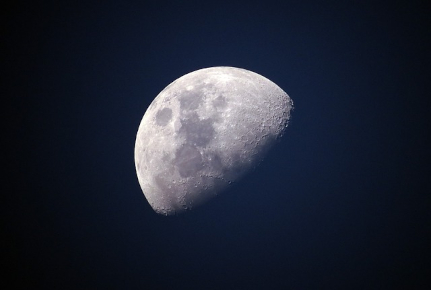Do you love to look at the moon? Is it maybe your dream to visit it one day? Or is the moon something you never really thought about for longer? Either way, I will give you some interesting facts about the beautiful rock lighting up our night on Earth (by the way: the moon doesn’t actually shine itself but reflects the sunlight).

- The moon is ¼ the size of the Earth
With the earth measuring a diameter of 12,7km, the moon is around 73% smaller with only 3,476km. Nevertheless, the diameter ratio of satellite to the planet is a lot bigger compared to other satellite-planet pairs, which means that the moon has a big impact on life on our planet. - Temperatures vary very heavily
In contrast to the earth, the moon does not have a protective atmosphere around it. This means that the heat can’t be trapped near the surface as it happens on earth, which then leads to drastic temperature changes. When the sun hits the moon, temperatures get as high as 107°C and when the moon is ‘dark’ the moon has a temperature of around -153°C. Since there is no weather on the moon, dust or footprints can stay untouched for centuries! - The moon might have been formed 4,5 billion years ago
One of the theories on how the moon formed is called the “large impact theory”. It states that a mars-sized rock named Theia crashed into the earth around 4.5 billion years ago with an impact 100 million times stronger than the comet that killed the dinosaurs. The debris that was created is said to have formed together as the moon. - The moon causes the tides on Earth
The moon’s gravity pulls at the Earth and causes the tides we know. These rises and falls are predictable since the moon and the Earth orbit the sun together. Even though we can’t see them as easily as tides in the ocean, the moon also has an effect on lakes, the atmosphere and the Earth’s crust. High tides happen on the side closest to the moon and the side furthest from it. Low tides can be found between these two. - The moon gets smaller every year
On average the moon has a distance of 384,400km from Earth. The moon’s gravity is what causes the tides in our oceans but it’s also responsible for slowing the Earth’s rotation. The tidal braking increases our days by 2.3 milliseconds per century. Because the Earth slows down, it loses a part of its energy which gets picked up by the moon and causes it to drift away from us. Researchers say that the moon might have been around 12-19 times closer to Earth than it is now! That would mean a distance of only 20,000 – 30,000km and not over 380,000km as it is today. Our moon travels around 3,8centimeters away from Earth per year, around the same speed that your fingernails grow.

I hope you learned something new through this article and can appreciate the moon a little more the next time you see it.
Sources:
https://www.natgeokids.com/uk/discover/science/space/facts-about-the-moon/
https://www.space.com/55-earths-moon-formation-composition-and-orbit.html
https://www.nationalgeographic.co.uk/space/2019/01/10-amazing-facts-about-the-moon
https://www.rd.com/list/moon-facts/

